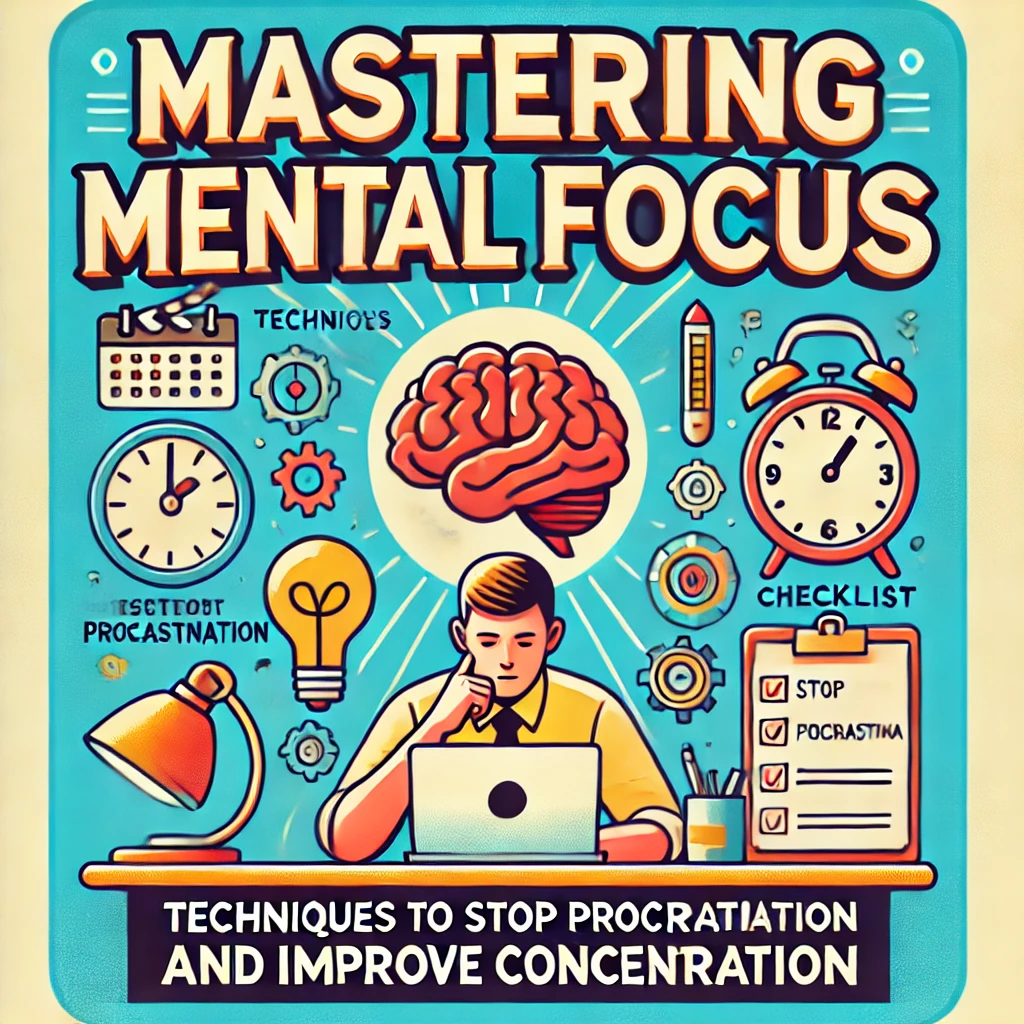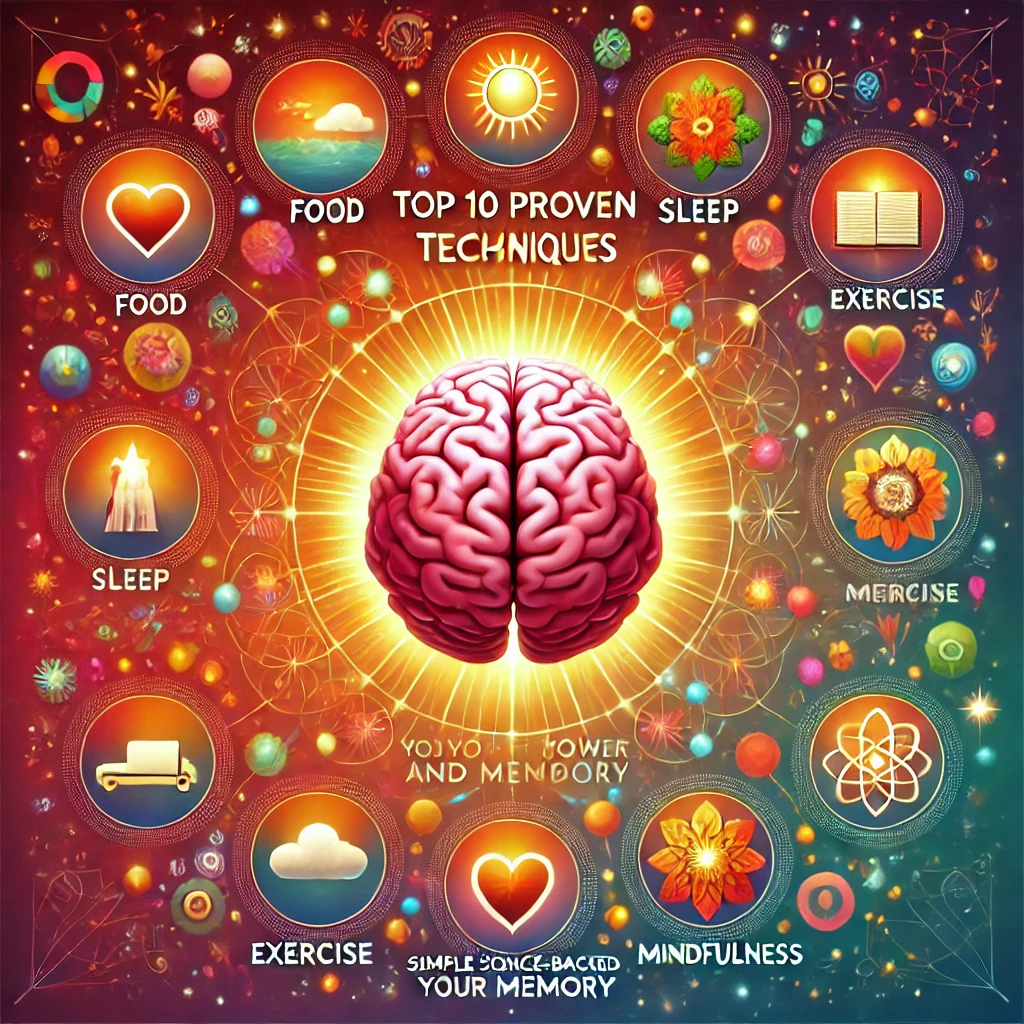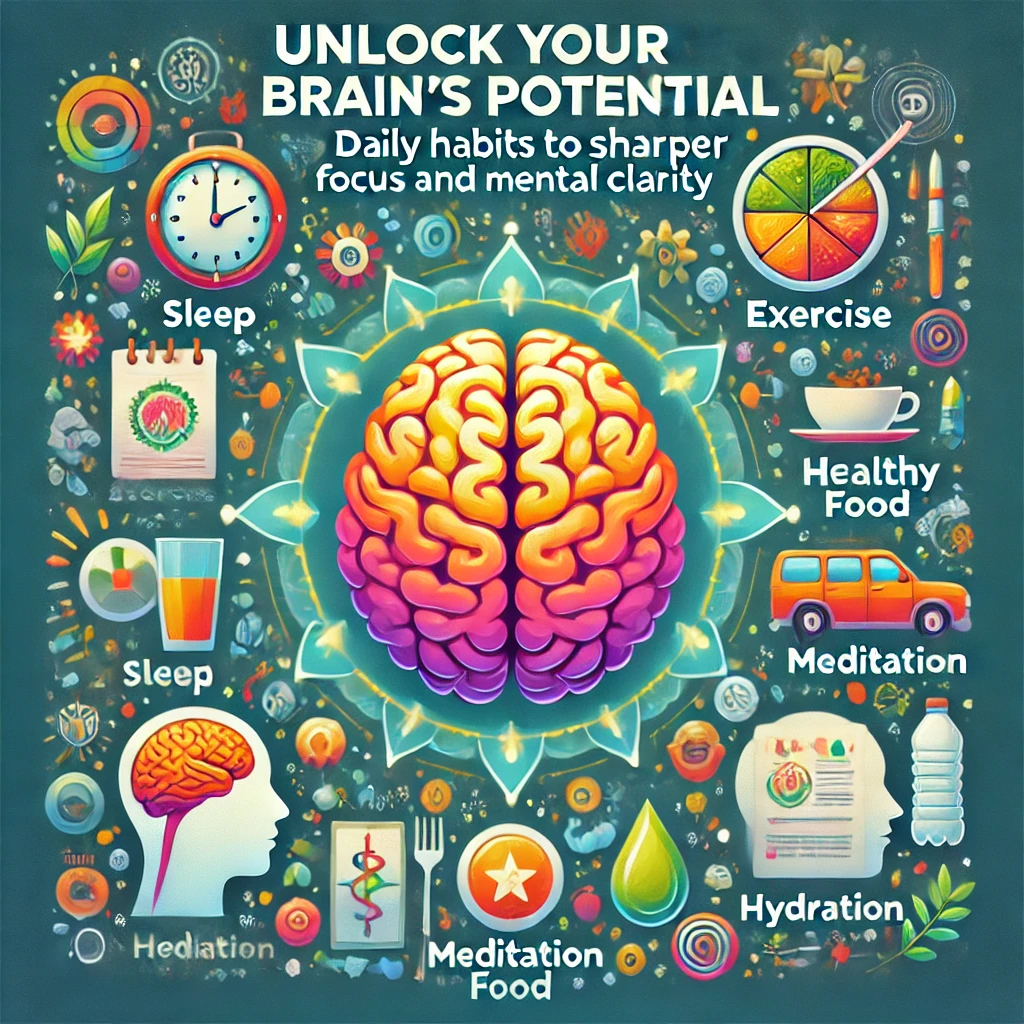Introduction
We’ve all been there: you have a list of tasks to tackle, but instead of diving in, you find yourself scrolling through social media or watching videos on repeat. Procrastination can be frustrating and all too common, especially when you’re struggling to concentrate. Learning how to stop procrastination and focus is essential for staying productive and achieving your goals. But where do you start?
In this article, we’ll explore proven strategies to improve concentration, enhance mental clarity, and kick procrastination to the curb. By mastering mental focus, you’ll find it easier to stay on track, get things done, and ultimately, feel more accomplished at the end of the day. Let’s dive in!
1. Understanding Procrastination: Why Do We Put Things Off?
Before we dive into techniques to improve mental focus, it’s helpful to understand why we procrastinate in the first place. Procrastination isn’t just about laziness; it’s often a way to cope with certain emotions, like fear of failure, perfectionism, or simply feeling overwhelmed by a task.
Common reasons for procrastination:
- Fear of failure: We avoid tasks because we’re worried about not doing them well.
- Perfectionism: The desire to do something perfectly can make it hard to get started.
- Feeling overwhelmed: When a task feels too big or complex, we tend to avoid it.
- Lack of motivation: Sometimes, we simply don’t feel connected to the task.
Relatable anecdote:
I used to procrastinate on writing projects, waiting until the last minute because I was afraid they wouldn’t turn out the way I envisioned. Once I realized that fear was holding me back, I began implementing small steps to make the process less daunting. It turned out that starting was half the battle!
2. Set Clear Goals and Break Down Tasks
One of the most effective strategies to stay focused and productive is to set clear, achievable goals. When tasks feel vague or too large, our brains naturally want to avoid them. Breaking tasks down into smaller, manageable steps makes them feel less intimidating and provides a sense of progress.
How to set clear goals:
- Use the SMART framework: Make goals Specific, Measurable, Achievable, Relevant, and Time-bound.
- Break it down: Divide big projects into smaller tasks. For example, if you’re writing a report, start with an outline before moving to the first section.
- Focus on one step at a time: Concentrating on smaller tasks helps boost concentration and mental clarity, making the project feel more manageable.
Example:
If you need to prepare a presentation, start by creating a rough outline of key points. Then, break it down further into creating slides, gathering data, and practicing delivery. By focusing on each small step, the task becomes more approachable.
3. Practice the Pomodoro Technique for Better Focus
The Pomodoro Technique is a popular time management method designed to help you stay focused for short, intense intervals with breaks in between. This technique works by breaking tasks into 25-minute intervals, known as “Pomodoros,” followed by a five-minute break. After four Pomodoros, take a longer break of 15-30 minutes.
Why it works:
This method trains your brain to focus for short periods, making it easier to maintain concentration without burning out. The scheduled breaks help prevent mental fatigue, allowing you to return to your work feeling refreshed.
How to use the Pomodoro Technique:
- Choose a task to focus on.
- Set a timer for 25 minutes and work on the task until the timer goes off.
- Take a five-minute break.
- Repeat this process four times, then take a longer break.
Relatable anecdote:
I once had a big project that I kept putting off because it seemed too overwhelming. But when I started using the Pomodoro Technique, I found it easier to focus for those 25-minute blocks, and the breaks helped me feel less drained. It became my go-to approach for tackling large projects.
4. Eliminate Distractions: Create a Focus-Friendly Environment
Distractions are one of the biggest obstacles to concentration and productivity. Whether it’s phone notifications, background noise, or even clutter, minimizing distractions is essential for improving focus.
How to create a distraction-free environment:
- Silence notifications: Turn off notifications on your phone or put it in “Do Not Disturb” mode while working.
- Use noise-canceling headphones: If you’re in a noisy environment, listening to white noise or instrumental music can help maintain focus.
- Declutter your workspace: A clean, organized space can help reduce mental distractions and boost concentration.
Example:
A friend of mine always struggled to focus in her cluttered home office. After taking a weekend to declutter and rearrange her space, she noticed an immediate improvement in her productivity. Her mind felt as clear as her desk!
5. Practice Mindfulness and Meditation for Mental Clarity
Mindfulness and meditation are powerful tools to enhance mental focus and reduce procrastination. These practices train your brain to stay present, making it easier to concentrate on tasks without getting distracted by wandering thoughts.
Benefits of mindfulness for focus:
- Reduces mental clutter: Meditation clears your mind, helping you stay present and focused.
- Improves attention span: Regular practice enhances concentration, allowing you to work for longer periods without distraction.
- Increases resilience to stress: Mindfulness helps manage stress, which can often be a cause of procrastination.
How to get started:
Set aside just five minutes a day to focus on your breath. Apps like Headspace or Insight Timer can guide you through meditation practices if you’re new to it. As you build consistency, increase your meditation time gradually.
Relatable anecdote:
I used to feel scattered and easily distracted until I began practicing mindfulness each morning. Even a short five-minute meditation made a noticeable difference, helping me approach my work with a clear and focused mind.
6. Overcoming Procrastination Techniques: The Two-Minute Rule
The Two-Minute Rule is a simple, effective way to break through procrastination. The idea is to start with tasks that take two minutes or less. This small action creates momentum, making it easier to move on to more significant tasks.
Why it works:
Starting small reduces the mental resistance to getting started, and it often leads to more progress than you’d expect. Once you’ve completed a simple task, you’re more likely to continue working.
How to apply the Two-Minute Rule:
Begin by choosing a small task related to your bigger goal. For example, if you’re working on a report, spend just two minutes jotting down ideas. This “foot in the door” approach can be incredibly powerful in breaking down procrastination barriers.
7. Use Visualization Techniques to Boost Motivation
Visualization is a technique that involves imagining yourself successfully completing a task. It’s a powerful way to motivate yourself and boost concentration by creating a mental roadmap of your goals.
How to use visualization for focus:
- Picture the end result: Imagine the feeling of accomplishment you’ll have once the task is completed.
- Visualize the process: Mentally walk through each step required to complete the task, focusing on how you’ll feel as you progress.
- Use positive affirmations: Pair visualization with affirmations like, “I am capable of staying focused” or “I am productive and motivated.”
Relatable anecdote:
Whenever I had a big project, I’d get anxious thinking about all the work involved. But after I started visualizing myself finishing each step, I felt more motivated and found it easier to get started. Visualizing success made me believe it was achievable, which helped me focus and get things done.
8. Fuel Your Brain with Healthy Nutrition
What you eat has a significant impact on your mental clarity and focus. Foods high in sugar or processed ingredients can lead to energy crashes, while nutrient-rich foods support sustained mental energy and concentration.
Brain-boosting foods to include in your diet:
- Leafy greens: Spinach, kale, and other greens are rich in antioxidants and nutrients that support brain health.
- Omega-3 fatty acids: Found in fish, walnuts, and flaxseeds, omega-3s improve cognitive function and memory.
- Whole grains: Complex carbs like oats and quinoa provide steady energy, keeping your brain fueled for longer periods.
Example:
A colleague once complained about his afternoon brain fog until he swapped his sugary snacks for nuts and fruit. The change helped him stay alert and focused throughout the day.
9. Embrace “Single-Tasking” to Master Focus
In a world where multitasking is the norm, single-tasking—or focusing on one task at a time—is often a more effective strategy for mastering focus. Single-tasking allows your brain to dive deeper into each task, enhancing productivity and reducing the mental toll of switching between different tasks.
Benefits of single-tasking:
- Improves productivity: Focusing on one task at a time increases efficiency and quality of work.
- Reduces mental fatigue: Switching tasks frequently can drain mental energy, whereas single-tasking helps conserve it.
- Boosts concentration and mental clarity: Single-tasking enhances focus, making it easier to tackle complex tasks.
How to practice single-tasking:
Identify your top priority for the day, then work on that task without interruptions until it’s complete or you reach a natural stopping point. Resist the urge to switch to another task, and
keep distractions at bay.
10. Set Realistic Deadlines and Reward Yourself
Setting realistic deadlines can help you manage your time effectively and avoid procrastination. By breaking larger projects into smaller, time-bound goals, you’ll make progress without feeling overwhelmed.
How to set realistic deadlines:
- Break tasks down: Divide projects into smaller steps and assign each a deadline.
- Schedule breaks: Plan short breaks to recharge and avoid burnout.
- Reward yourself: Celebrating small wins can help you stay motivated and focused on your goals.
Relatable anecdote:
When working on long-term projects, I used to get discouraged by the sheer volume of work. But when I began breaking down tasks with realistic deadlines and rewarding myself along the way, I felt more motivated and capable of finishing each step.
Conclusion
Procrastination and difficulty focusing are common challenges, but they don’t have to stand in your way. By incorporating these techniques—setting clear goals, practicing mindfulness, eliminating distractions, and fueling your brain with the right nutrients—you can improve concentration, boost mental clarity, and build long-lasting habits for productivity.
Remember, mastering mental focus takes time, so start small and build your concentration skills step by step. These techniques to improve mental focus and overcome procrastination can make a real difference in your productivity and peace of mind, helping you achieve your goals and feel more accomplished each day.
FAQ Section
1. What causes procrastination?
Procrastination can stem from fear of failure, perfectionism, feeling overwhelmed, or lack of motivation. Understanding the root cause can help you find effective strategies to overcome it.
2. How can I improve my concentration naturally?
Natural ways to improve concentration include practicing mindfulness, staying hydrated, eating brain-boosting foods, and setting a distraction-free environment.
3. What is the Pomodoro Technique?
The Pomodoro Technique is a time management method that involves working in 25-minute intervals (Pomodoros) followed by short breaks to improve focus and prevent burnout.
4. How does nutrition impact mental clarity?
A balanced diet rich in whole foods, omega-3s, and antioxidants supports mental clarity and sustained focus, while processed foods can lead to energy crashes.
5. Can meditation help with focus?
Yes, meditation can help improve focus by training your mind to stay present and manage distractions, reducing mental clutter over time.
6. What is the Two-Minute Rule for overcoming procrastination?
The Two-Minute Rule suggests starting with a task that takes two minutes or less. This creates momentum and makes it easier to move on to larger tasks.
7. How can I create a distraction-free workspace?
You can reduce distractions by silencing phone notifications, organizing your desk, and using noise-canceling headphones if needed.
8. Is multitasking bad for concentration?
Yes, multitasking can reduce concentration and lead to mental fatigue. Single-tasking, or focusing on one task at a time, is often more effective for productivity.
9. How do I set realistic deadlines to avoid procrastination?
Break tasks into smaller steps and assign each a deadline. Take breaks to recharge, and reward yourself for completing each step to stay motivated.



